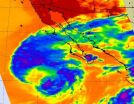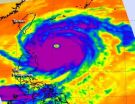(Press-News.org) VIDEO:
Supercomputer models of merging black holes reveal properties that are crucial to understanding future detections of gravitational waves. This movie follows two orbiting black holes and their accretion disk during...
Click here for more information.
According to Einstein, whenever massive objects interact, they produce gravitational waves -- distortions in the very fabric of space and time -- that ripple outward across the universe at the speed of light. While astronomers have found indirect evidence of these disturbances, the waves have so far eluded direct detection. Ground-based observatories designed to find them are on the verge of achieving greater sensitivities, and many scientists think that this discovery is just a few years away.
Catching gravitational waves from some of the strongest sources -- colliding black holes with millions of times the sun's mass -- will take a little longer. These waves undulate so slowly that they won't be detectable by ground-based facilities. Instead, scientists will need much larger space-based instruments, such as the proposed Laser Interferometer Space Antenna, which was endorsed as a high-priority future project by the astronomical community.
A team that includes astrophysicists at NASA's Goddard Space Flight Center in Greenbelt, Md., is looking forward to that day by using computational models to explore the mergers of supersized black holes. Their most recent work investigates what kind of "flash" might be seen by telescopes when astronomers ultimately find gravitational signals from such an event.
Studying gravitational waves will give astrophysicists an unprecedented opportunity to witness the universe's most extreme phenomena, leading to new insights into the fundamental laws of physics, the death of stars, the birth of black holes and, perhaps, the earliest moments of the universe.
A black hole is an object so massive that nothing, not even light, can escape its gravitational grip. Most big galaxies, including our own Milky Way, contain a central black hole weighing millions of times the sun's mass, and when two galaxies collide, their monster black holes settle into a close binary system.
"The black holes orbit each other and lose orbital energy by emitting strong gravitational waves, and this causes their orbits to shrink. The black holes spiral toward each other and eventually merge," said Goddard astrophysicist John Baker.
Close to these titanic, rapidly moving masses, space and time become repeatedly flexed and warped. Just as a disturbance forms ripples on the surface of a pond, drives seismic waves through Earth, or puts the jiggle in a bowl of Jell-O, the cyclic flexing of space-time near binary black holes produces waves of distortion that race across the universe.
While gravitational waves promise to tell astronomers many things about the bodies that created them, they cannot provide one crucial piece of information -- the precise position of the source. So to really understand a merger event, researchers need an accompanying electromagnetic signal -- a flash of light, ranging from radio waves to X-rays -- that will allow telescopes to pinpoint the merger's host galaxy.
Understanding the electromagnetic counterparts that may accompany a merger involves the daunting task of tracking the complex interactions between the black holes, which can be moving at more than half the speed of light in the last few orbits, and the disks of hot, magnetized gas that surround them. Since 2010, numerous studies using simplifying assumptions have found that mergers could produce a burst of light, but no one knew how commonly this occurred or whether the emission would be strong enough to be detectable from Earth.
To explore the problem in greater detail, a team led by Bruno Giacomazzo at the University of Colorado, Boulder, and including Baker developed computer simulations that for the first time show what happens in the magnetized gas (also called a plasma) in the last stages of a black hole merger. Their study was published in the June 10 edition of The Astrophysical Journal Letters.
The simulations follow the complex electrical and magnetic interactions in the ionized gas -- known as magnetohydrodynamics -- within the extreme gravitational environment determined by the equations of Einstein's general relativity, a task requiring the use of advanced numerical codes and fast supercomputers.
Both of the simulations reported in the study were run on the Pleiades supercomputer at NASA's Ames Research Center in Moffett Field, Calif. They follow the black holes over their last three orbits and subsequent merger using models both with and without a magnetic field in the gas disk.
Additional simulations were run on the Ranger and Discover supercomputers, respectively located at the University of Texas, Austin, and the NASA Center for Climate Simulation at Goddard, in order to investigate the effects of different initial conditions, fewer orbits and other variations.
"What's striking in the magnetic simulation is that the disk's initial magnetic field is rapidly intensified by about 100 times, and the merged black hole is surrounded by a hotter, denser, thinner accretion disk than in the unmagnetized case," Giacomazzo explained.
In the turbulent environment near the merging black holes, the magnetic field intensifies as it becomes twisted and compressed. The team suggests that running the simulation for additional orbits would result in even greater amplification.
The most interesting outcome of the magnetic simulation is the development of a funnel-like structure -- a cleared-out zone that extends up out of the accretion disk near the merged black hole. "This is exactly the type of structure needed to drive the particle jets we see from the centers of black-hole-powered active galaxies," Giacomazzo said.
The most important aspect of the study is the brightness of the merger's flash. The team finds that the magnetic model produces beamed emission that is some 10,000 times brighter than those seen in previous studies, which took the simplifying step of ignoring plasma effects in the merging disks.
"We need gravitational waves to confirm that a black hole merger has occurred, but if we can understand the electromagnetic signatures from mergers well enough, perhaps we can search for candidate events even before we have a space-based gravitational wave observatory," Baker said.
### END
Simulations uncover 'flashy' secrets of merging black holes
2012-09-28
ELSE PRESS RELEASES FROM THIS DATE:
Landsat satellites find the 'sweet spot' for crops
2012-09-28
Farmers are using maps created with free data from NASA and the U.S. Geological Survey's Landsat satellites that show locations that are good and not good for growing crops.
Farmer Gary Wagner walks into his field where the summer leaves on the sugar beet plants are a rich emerald hue -- not necessarily a good color when it comes to sugar beets, either for the environment or the farmer. That hue tells Wagner that he's leaving money in the field in unused nitrogen fertilizer, which if left in the soil can act as a pollutant when washed into waterways, and in unproduced ...
NASA sees a western weakness in Tropical Storm Miriam
2012-09-28
NASA infrared satellite imagery showed Tropical Storm Miriam had strong convection and thunderstorm activity in all quadrants of the storm on Sept. 26, except the western quadrant. That activity waned dramatically in 24 hours because of strong wind shear and cooler sea surface temperatures.
The Atmospheric Infrared Sounder (AIRS) instrument that flies aboard NASA's Aqua satellite captured infrared data on Tropical Storm Miriam on Sept. 26 at 2047 UTC, when it was off the coast of Baja California. Strongest thunderstorms with very cold cloud top temperatures appear to ...
NASA sees a wide-eyed Super Typhoon Jelawat
2012-09-28
One day ago, Super Typhoon Jelawat's eye was about 25 nautical miles in diameter, today, Sept. 27, NASA satellite data indicated that eye has grown to 36 nautical miles!
The latest infrared image from the Atmospheric Infrared Sounder (AIRS) instrument that flies on NASA's Aqua satellite shows a clear eye in Typhoon Jelawat on Sept. 25. The cloud top temperatures of the thunderstorms surrounding the eye exceed -63 Fahrenheit (-52 Celsius) indicating that they are very powerful and heavy rainmakers.. Jelawat also has a rounded shape indicating that circulation is strong ...
NASA sees Tropical Storm Ewiniar embedded in low pressure
2012-09-28
NASA's Aqua satellite passed over Tropical Storm Ewiniar and noticed strong convection still persists in the storm, despite now being embedded in a subtropical area of low pressure off the coast of Japan.
As Tropical Storm Ewiniar continues to move northward it wound up in an elongated area of low pressure (called a trough) off Japan's east coast. The trough is bringing a strong westerly flow of air into Ewiniar. Despite being battered by those winds, infrared data from the Atmospheric Infrared Sounder (AIRS) instrument that flies aboard NASA's Aqua satellite is showing ...
Study shows the MDHearingAid to be an effective low cost solution to hearing loss
2012-09-28
Washington, D.C. - A study presented at the American Academy of Otolaryngology - Head & Neck Surgery Foundation Annual Meeting in Washington, D.C. shows that the MD Hearing Aid line offers a reasonable low-cost solution to those who are not using hearing aids or other amplification devices because of cost concerns.
In the study, researchers at the Michigan Ear Institute sought to evaluate a novel, inexpensive (under $200.) over- the-counter hearing aid regarding to its acoustic properties and also to test the hearing aid on patients with varying levels of hearing loss ...
Major genetic discovery explains 10 percent of aortic valve disease
2012-09-28
This press release is available in French and German.MONTREAL, Canada, September 28, 2012 - Researchers at the Sainte-Justine University Hospital Center and University of Montreal have identified genetic origins in 10% of an important form of congenital heart diseases by studying the genetic variability within families. "This is more than the sum of the genes found to date in all previous studies, which explained only 1% of the disease, says Dr. Marc-Phillip Hitz, lead author of the study published in PLOS Genetics, under the direction of Dr. Gregor Andelfinger, pediatric ...
Making headway on beta-blockers and sleep
2012-09-28
Boston, MA—Over 20 million people in the United States take beta-blockers, a medication commonly prescribed for cardiovascular issues, anxiety, hypertension and more. Many of these same people also have trouble sleeping, a side effect possibly related to the fact that these medications suppress night-time melatonin production. Researchers at Brigham and Women's Hospital (BWH) have found that melatonin supplementation significantly improved sleep in hypertensive patients taking beta-blockers.
The study will be electronically published on September 28, 2012 and will be ...
Effective HIV care benefited all HIV patients, regardless of demographics and behavioral risk
2012-09-28
Improved treatment options, a multi-pronged treatment model, and federal funding from the Ryan White Program have helped an inner city Baltimore clinic improve outcomes for HIV patients across all groups, including those most often hardest hit by the disease. Published in Clinical Infectious Diseases, the results from the 15-year analysis of patients at a clinic serving a primarily poor, African-American patient population with high rates of injection drug use demonstrate what state-of-the-art HIV care can achieve, given appropriate support.
Current antiretroviral therapy ...
Eliminating invasive cervical cancer possible, Moffitt Cancer Center researchers report
2012-09-28
Researchers at Moffitt Cancer Center and colleagues at the University of South Florida and The Ohio State University have published a paper in the September issue of Cancer Epidemiology, Biomarkers & Prevention that provides an overview on preventing invasive cervical cancer.
"The good news is that over the past several decades, the incidence of invasive cervical cancer has declined dramatically," said senior author Anna R. Giuliano, Ph.D., director of Moffitt's Center for Infection Research in Cancer and senior member of the Cancer Epidemiology Department. "The bad ...
Gout guidelines arm patients and physicians with tools to fight painful disease
2012-09-28
Gout is one of the most common forms of inflammatory arthritis, affecting nearly 4% of adult Americans. Newly approved guidelines that educate patients in effective methods to prevent gout attacks and provide physicians with recommended therapies for long-term management of this painful disease are published in Arthritis Care & Research, a peer-reviewed journal of the American College of Rheumatology (ACR).
Uric acid is produced by the metabolism of purines, which are found in foods and human tissue. When uric acid levels increase, crystals can form and deposit in joints, ...



